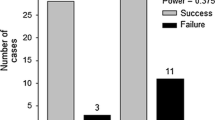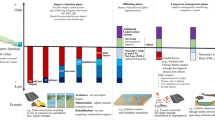Abstract
Both ecological and economic impacts factor into invasive alien species (IAS) management considerations; however, economic impacts are often difficult to assess, much less quantify. Studies frequently aggregate identified financial costs as a proxy for IAS economic impacts, but these aggregate figures are often generated in an ad hoc fashion. Such estimates typically sum disparate costs, which might vary with respect to precision, accuracy, and scope. A standardized approach for IAS costing would better enable the comparison of cost estimates between taxa and across studies by controlling for surveying and scaling inconsistencies. This study develops a simple, survey-based approach to generate economic cost estimates for non-native freshwater invasive species (FIS) in Great Britain. The approach scales an average cost for each species by a ratio of management effort, thereby estimating the actual, annual expenditures incurred by a variety of stakeholders. The Great Britain-wide cost of controlling FIS is estimated to be approximately £26.5 million year−1; however, the costs of control could total £43.5 million year−1 if management efforts were undertaken at all FIS infested locations. Cost estimates are highest for Canadian pondweed (Elodea canadensis), a particularly widespread species, and for the zebra mussel (Dreissena polymorpha), which adversely impacts both industrial water users and boaters. This assessment of the relative economic impacts between species provides policy-makers with a monetary basis for rank-ordering species’ economic impacts and prioritizing management efforts. In addition, the cost assessment approach developed in this study could serve as a model for IAS economic impact assessments elsewhere.




Similar content being viewed by others
References
Aldridge DC, Elliott P, Moggridge GD (2004) The recent and rapid spread of the zebra mussel (Dreissena polymorpha) in Great Britain. Biol Conserv 119(2):253–261
Andreu J, Vilà M, Hulme PE (2009) An assessment of stakeholder perceptions and management of noxious alien plants in Spain. J Environ Manag 43:1244–1255
British Waterways (2008) British Waterways Annual Report and Accounts 2007/08. Annual Report presented to the UK Parliament by the Secretary of State for Environment, Food and Rural Affairs and to the Scottish Parliament by Scottish Ministers in exercise of the powers conferred by section 24(3) and 27(8) of the Transport Act 1962
Britton JR, Brazier M (2006) Eradicating the invasive topmouth gudgeon, Pseudorasbora parva, from a recreational fishery in northern England. Fish Manag Ecol 13(5):329–335
Britton JR, Davies GD, Brazier M (2009) Towards the successful control of Pseudorasbora parva in the UK. Biol Invasions. doi:10.1007/s10530-009-9436-1
CABI Bioscience (CABI) (2009) Azolla control: natures answer. http://194.203.77.76/AzollaControl/HTML/About.htm. Accessed 9 April 2009
Carson RT (2000) Contingent valuation: a user’s guide. Environ Sci Technol 34(8):1413–1418
Cohen AN, Carlton JT, Fountain MC (1995) Introduction, dispersal and potential impacts of the green crab Carcinus maenas in San Francisco Bay, California. Mar Biol 122:225–237
Colautti RI, Bailey SA, van Overdijk CDA, Amundsen K, MacIsaac HJ (2006) Characterized and projected costs of nonindigenous species in Canada. Biol Invasions 8:45–59
Cusack C, Harte M, Chan S (2009) The economics of invasive species. Prepared for the Oregon Invasive Species Council, Sea Grant Oregon, Corvallis, OR 11 pp
Department for Environment, Food, Rural Affairs (Defra) (2003) Review of non-native species policy: report of the working group. Defra Publications, London
Department for Environment, Food, Rural Affairs (Defra) (2007) Consultation on: (1) The review of schedule 9 to the Wildlife and Countryside Act 1981 and (2) the ban on sale of certain non-native species. Defra Publications, London
Department for Environment, Food, Rural Affairs (Defra) (2008) The invasive non-native species framework strategy for Great Britain: protecting our natural heritage from invasive species. The GB Non-native Species Secretariat, London
Elliott P (2005) The zebra mussel in England: biology, impacts, and control using micro-encapsulated toxins. PhD thesis, University of Cambridge
Environment Agency (EA) (2006) “Top ten most wanted foreign species.” Environment Agency News Release 3 August 2006
Environment Agency (EA) (2009) Freshwater crayfish in Britain and Ireland. The Environment Agency, Bristol
Environmental Protection Agency (EPA) (2005) Economic impacts of aquatic invasive species workshop. Office of Water; Office of Policy; Economics and Innovation, Washington, DC 91 pp
Gassman A, Cock MJW, Shaw R, Evans HC (2006) The potential for biological control of invasive alien aquatic weeds in Europe: a review. Hydrobiol 570:217–222
Gozlan RE (2008) Introduction of non-native freshwater fish: is it all bad? Fish Fish 9:106–115
Gren IM (2008) Economics of alien invasive species management—choices of targets and policies. Boreal Environ Res 13:17–32
Herborg LM, Rushton SP, Clare AS, Bentley MG (2005) The invasion of the Chinese mitten crab (Eriocheir sinensis) in the United Kingdom and its comparison to continental Europe. Biol Invasions 7:959–968
Hickley P, Chare S (2004) Fisheries for non-native species in England and Wales: angling or the environment? Fish Manag Ecol 11:203–212
Holdich DM (1993) A review of astaciculture: freshwater crayfish farming. Aquat Living Resour 6:307–317
Isom BG (1986) Historical review of Asiatic clam (Corbicula) invasion and biofouling of waters and industries in the Americas. Am Malacol Bull Spec 2:1–5
Johanna GM, Galbreath S, Smith JE, Terry RS, Becnel JJ, Dunn AM (2003) Invasion success of Fibrillanosema crangonycis, n.sp., n.g.: a novel vertically transmitted microsporidian parasite from the invasive amphipod host Crangonyx pseudogracilis. Int J Parasitol 34(2):235–244
Joint Nature Conservation Committee (JNCC) (2007) Tackling the threat of invasive non-native species. 28 February 2007. http://www.jncc.gov.uk/page-3946. Accessed on 19 April 2009
Keller RP, Frang K, Lodge DM (2008) Preventing the spread of invasive species: economic benefits of intervention guided by ecological principles. Conserv Biol 22(1):80–88
Keller RP, zu Ermgassen PS, Aldridge DC (2009) Vectors and timing of freshwater invasions in Great Britain. Conserv Biol. doi:10.1111/j.1523-1739.2009.01249.x
Kelly J (2003) Investigations into the application of Australian methods for the control and management of Carp (Cyprinus carpio) in New Zealand. Environment Waikato Technical Report TR04/03
Kettunen M, Genovesi P, Gollasch S, Pagad S, Starfinger U, ten Brink P, Shine C (2008) Technical support to EU strategy on invasive species (IAS)–Assessment of the impacts of IAS in Europe and the EU (final module report for the European Commission). Institute for European Environmental Policy (IEEP), Brussels, Belgium, 43 pp + Annexes
Leung B, Lodge DM, Finnoff D, Shogren JF, Lewis MA, Lamberti G (2002) An ounce of prevention equals a pound of cure: bioeconomic risk analysis of invasive species. Proc R Soc Lond 269:2407–2413
Lovell SJ, Stone SF, Fernandez L (2006) The economic impacts of aquatic invasive species: a review of the literature. Agric Resour Econ Rev 35(1):195–208
Manchester SJ, Bullock JM (2000) The impacts of non-native species on UK biodiversity and the effectiveness of control. J Appl Ecol 37(5):845–864
McConnachie AJ, de Wit MP, Hill MP, Byrne MJ (2003) Economic evaluation of the successful biocontrol of Azolla filiculoides in South Africa. Biol Control 28:25–32
Mediterranean European Plant Protection Organization (EPPO) (2006) Data sheets on quarantine pests: Hydrocotyle ranunculoides. Bulletin OEPP/EPPO Bulletin 36:3–6
Mediterranean European Plant Protection Organization (EPPO) (2007) Data sheets on quarantine pests: Crassula helmsii. Bulletin OEPP/EPPO Bulletin 37:225–229
Miller SA, Crowl TA (2006) Effects of common carp (Cyprinus carpio) on macrophyte and invertebrate communities in a shallow lake. Freshw Biol 51:85–94
Minchin D, Rosenthal H (2002) Exotics for stocking and aquaculture, making correct decisions. In: Leppakoski E, Gollasch S, Olenin S (eds) Invasive aquatic species of europe: distribution, impacts and management. Springer, pp, pp 206–216
National Biodiversity Network (2009a) Crayfish (Crustacea: Astacura) data for Britain and Ireland to 2003 http://www.nbn.org.uk/. Accessed on 1 June 2009
National Biodiversity Network (2009b) Crayfish data update for Environment Agency Thames Region March 2009 (2009). http://www.nbn.org.uk/. Accessed on 1 June 2009
National Biodiversity Network (2009c) Database for the Atlas of Freshwater Fishes (2009) http://www.nbn.org.uk/. Accessed on 1 June 2009
National Biodiversity Network (2009d) Invertebrate Site Register – England (2009) http://www.nbn.org.uk/. Accessed on 1 June 2009
National Biodiversity Network (2009e) Mollusc (non-marine) data for Great Britain and Ireland http://www.nbn.org.uk/. Accessed on 1 June 2009
National Biodiversity Network (2009f) Seasearch Marine Surveys 2009 http://www.nbn.org.uk/. Accessed on 1 June 2009
National Biodiversity Network (2009g) Vascular Plants Database 2009. http://www.nbn.org.uk/. Accessed on 1 June 2009
National Biodiversity Network (2009h) Volunteer sightings data held by DASSH Data Archive Centre 2009. http://www.nbn.org.uk/. Accessed on 1 June 2009
O’Neill CR (1997) Economic impact of zebra mussels–Results of the 1995 National Zebra Mussel information clearinghouse study. Gt Lakes Res Rev 3(1):35–44
Park J, Hushak LJ (1999) Zebra mussel control costs in surface water using facilities. Technical summary No. OHSU-TS-028. Ohio Sea Grant College Program, Ohio State University, Columbus, OH 15 pp
Parker IM, Simberloff D, Lonsdale WM, Goodell K, Wonham M, Kareiva PM, Williamson MH, Von Holle B, Moyle PB, Byers JE, Goldwasser L (1999) Impact: toward a framework for understanding the ecological effects of invaders. Biol Invasions 1:3–19
Parliamentary Office of Science and Technology (POST) (2008) Invasive Non-native Species. POSTnote 303, London
Perrings C (2002) Biological invasions in aquatic systems: the economic problem. Bull Mar Sci 70(2):541–552
Pimentel D (ed) (2002) Biological invasions: economic and environmental costs of alien plants, animals and microbe species. CRC Press, USA
Pimentel D (2005) Aquatic nuissance species in the New York state canal and Hudson River systems and the great lakes basin: an economic and environmental assessment. J Environ Manag 35(5):692–702
Pimentel D, Lach L, Zuniga R, Morrison D (2000) Environmental and economic costs of non-indigenous species in the United States. Biosci 50(1):56–65
Pimentel D, McNair S, Janecka J, Wightman J, Simmonds C, O’Connell C, Wong E, Russel L, Zern J, Aquino T, Tsomondo T (2001) Economic and environmental threats of alien plant, animal, and microbe invasions. Agric Ecosyst Environ 84(1):1–20
Pimentel D, Zuniga R, Morrison D (2005) Update on the environmental and economic costs associated with alien-invasive species in the United States. Ecol Econ 52:273–288
Shaw D, Tanner R (2008) Weed like to see less of them. Biol 55(4):208–214
Sheppard AW, Shaw RH, Sforza R (2005) Top 20 environmental weeds for classical biological control in Europe: a review of opportunities, regulations and other barriers to adoption. Weed Res 46(2):93–117
United Kingdom Technical Advisory Group (UKTAG) Alien Species Group (2004) Guidance on the assessment of alien species pressures. TAG 2004 7 g Guidance on assessment of alien species (PRI-16-03-04)
United Kingdom Technical Advisory Group (UKTAG) Alien Species Group (2008) Alien Species Revised TAG Table http://www.wfduk.org/tag_guidance/Article_05/Folder.2004-02-16.5332/view. Accessed on 16 February 2009
United States Government Accountability Office (USGAO) (2002) Invasive species: clearer focus and greater commitment needed to effectively manage the problems. Report to Executive Agency Officials, GAO-03-1, October 2001
United States Office of Technology Assessment (USOTA) (1993) Harmful non-indigenous species in the United States. US Congress, Washington, D.C
Vilà M, Basnou C, Pysek P, Josefsson M, Genovesi P, Gollasch S, Nentwig W, Olenin S, Roques A, Roy D, Hulme PE, DAISIE partners (2009) How well do we understand the impacts of alien species on ecosystem services? A pan-European cross-taxa assessment. Front Ecol Environ. doi:10.1890/080083
Wade M, Fasham M, Booy O, White V (2007) Audit of responsibilities for non-native species within government departments, non-departmental public bodies, agencies, and local governments in England, Scotland and Wales. RPS. http://www.nonnativespecies.org/documents/ JPP1294%20Defra%20Audit%20Final.pdf. Accessed 24 March 2009
Warren CR (2007) Perspectives on the ‘alien’ versus ‘native’ species debate: a critique of concepts, language and practice. Prog Hum Geogr 31(4):427–446
Xu H, Ding H, Li M, Qiang S, Guo J, Han Z, Huang Z, Sun H, He S, Wu H, Wan F (2006) The distribution and economic losses of alien species invasion to China. Biol Invasions. doi:10.1007/s10530-005-5841-2
Acknowledgments
Numerous individuals contributed to this study. The authors specifically wish to thank Kevin Ackerman, Andrew Balmford, Olaf Booy, Brendan Fisher, Reuben Keller, Tony Pickup, Trevor Renals, Bill Sutherland, and Line zu Ermgassen. This research was made possible by funding from the Gates Cambridge Trust. The authors also wish to thank the anonymous reviewers for their helpful feedback.
Author information
Authors and Affiliations
Corresponding author
Electronic supplementary material
Below is the link to the electronic supplementary material.
Rights and permissions
About this article
Cite this article
Oreska, M.P.J., Aldridge, D.C. Estimating the financial costs of freshwater invasive species in Great Britain: a standardized approach to invasive species costing. Biol Invasions 13, 305–319 (2011). https://doi.org/10.1007/s10530-010-9807-7
Received:
Accepted:
Published:
Issue Date:
DOI: https://doi.org/10.1007/s10530-010-9807-7




